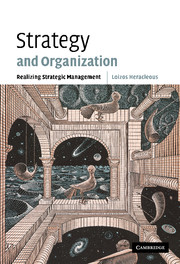Book contents
- Frontmatter
- Contents
- List of figures
- List of tables
- Preface
- I Bases of strategic management
- 1 The strategic management field
- 2 An organizational action view of strategic management
- 3 Strategic thinking or strategic planning?
- 4 Leadership research and the board of directors
- II Realizing strategy
- III Current themes and applications
- Index of names
- Index of subjects
- References
2 - An organizational action view of strategic management
Published online by Cambridge University Press: 11 May 2010
- Frontmatter
- Contents
- List of figures
- List of tables
- Preface
- I Bases of strategic management
- 1 The strategic management field
- 2 An organizational action view of strategic management
- 3 Strategic thinking or strategic planning?
- 4 Leadership research and the board of directors
- II Realizing strategy
- III Current themes and applications
- Index of names
- Index of subjects
- References
Summary
The dominant strategic management approaches discussed in chapter 1 have been criticized on various grounds, leading to the emergence of what may be called an “organizational action” (OA) view of strategic management. This chapter locates dominant strategic management approaches in the functionalist paradigm, outlines their main critiques, and discusses the emergence of the OA view in terms of applications of interpretive sociology and organization theory to strategic management. It then discusses the conceptual building blocks of the OA view and their interrelationships, and concludes with some key theoretical features of this emerging OA view.
Theoretical antecedents of the organizational action view
Functionalist and interpretive paradigms
The theoretical antecedents of the OA framework can be traced to applications of the interpretive sociological paradigm to strategic management (Chaffee 1985; Smircich and Stubbart 1985), as well as critiques of dominant strategic management approaches as deterministic in their assumptions, reductionist in their models, and insufficiently relevant to practice (Bettis 1991; Bourgeois 1984). Dominant strategic management approaches are located within the functionalist paradigm of social science (Burrell and Morgan 1979; Morgan 1980). This paradigm assumes that social phenomena have a concrete, solid reality underlain by a systemic orderliness; the goal of research is to understand the machine-like interactions of variables within this reality, so that one can ideally and ultimately control and predict them. Social scientists in this perspective aspire to the natural science positivist model; they imagine themselves to be outside and separate from their subject matter, and aspire to value free, “pure” science.
- Type
- Chapter
- Information
- Strategy and OrganizationRealizing Strategic Management, pp. 23 - 37Publisher: Cambridge University PressPrint publication year: 2003



